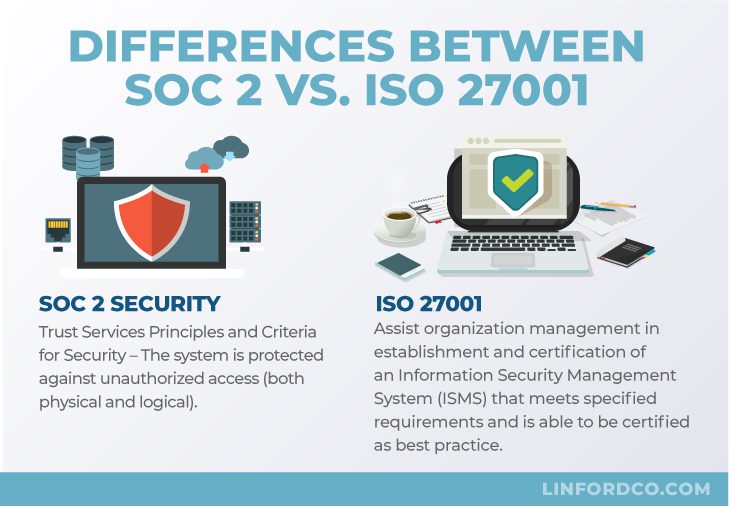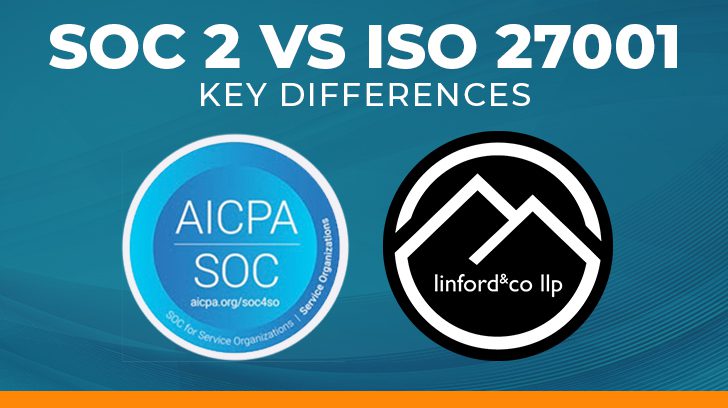On occasion, we hear variations of the following questions from clients and prospective clients:
- What are the differences between a SOC 2 and an ISO/IEC 27001:2022 audit?
- Which standard is more applicable to our company, SOC 2 or ISO/IEC 27001:2022?
- What are the advantages and disadvantages of SOC 2 vs. ISO/IEC 27001:2022?
- Is there a mapping between SOC 2 and ISO/IEC 27001:2022?
- Where is the overlap between SOC 2 and ISO/IEC 27001:2022?
What Is a SOC 2?
The American Institute of CPAs (AICPA) provides the following definition for SOC 2 – SOC for Service Organizations: Trust Services Criteria: “Report on Controls at a Service Organization Relevant to Security, Availability, Processing Integrity, Confidentiality, or Privacy”.
These reports are intended to meet the needs of a broad range of users that require detailed information and assurance about the controls at a service organization, relevant to security, availability, and processing integrity of their data systems. This is especially relevant for the systems employed to process users’ data and the confidentiality and privacy of the information processed by these systems.
These reports can play an important role in:
- Oversight of the organization.
- Vendor management programs.
- Internal corporate governance and risk management processes.
- Regulatory oversight.
Similar to a SOC 1 report, the reports may be either a point-in-time report (type I) or cover a period of time (type II). Therefore, there are two types of SOC 2 reports:
- The type I report focuses on management’s description of a service organization’s system, and the suitability of the design of its controls.
- The type II report focuses on management’s description of a service organization’s system, and the suitability of the design as well as the operating effectiveness of its controls.
Use of these reports is restricted. A SOC 2 report is an attestation report that documents an organization’s internal controls that are in place to meet the SOC 2 criteria for Security. A SOC 2 has the option for adding in criteria of Availability, Processing Integrity, Confidentiality, or Privacy as well.
SOC 2 reports may be prepared for International or US-based service organizations and shared with user entities of the service organizations. For more information on SOC 2 reports, see the following:
- A Guide to SOC 2 Compliance & Certification
- A SOC 2 Compliance Checklist Doesn’t Exist, But Guidance Does
- 2023 Trust Service Criteria(TSCs) for SOC 2 Reports
- SOC Report Benefits Beyond Compliance
- SOC 2 Considerations for SaaS Providers
- Choosing a SOC 2 Audit Firm
- Request a complimentary SOC 2 Consultation

What is ISO/IEC 27001:2022?
ISO/IEC 27001:2022 specifies the requirements for establishing, implementing, maintaining, and continually improving an information security management system (ISMS) within the context of the organization. It also includes requirements for the assessment and treatment of information security risks tailored to the needs of the organization.
The requirements set out in ISO/IEC 27001:2022 are generic and are intended to be applicable to all organizations, regardless of type, size or nature. ISO/IEC 27001:2022 certification validates that an organization meets the set requirements.
For more information on ISO/IEC 27001:2022, see the following:
- What is ISO?
- ISO and Risk Management Frameworks for Supporting Enterprise Risk Assessments
- ISO Certificate Verification: Considerations & Guidance
- Request an ISO Certification Assessment

SOC 2 vs. ISO/IEC 27001:2022: What Are the Key Differences?
The purpose of a SOC 2 compliance audit is to assist service organization management in reporting to customers that it has met established security criteria that determine that the system is protected against unauthorized access (both physical and logical). This is a standard, governed by the AICPA, and the SOC compliance audit is not a certification audit.
By contrast, the purpose of ISO/IEC 27001:2022 certification is to assist organization management in the establishment and certification of an Information Security Management System (ISMS) that meets specified requirements and is able to be certified as best practice. The International Organization for Standardization (ISO) and the International Electrotechnical Commission (IEC) developed ISO/IEC 27001:2022, an international standard.
SOC 2 audits are a good method that may be used to measure a service organization against static security principles and criteria. It can cover either a point in time, or a period of time. An ISO/IEC 27001:2022 audit is a best practice system that an entity may be certified against that is used to establish, implement, maintain, and improve security and addresses effectiveness of the system at a point in time.
It’s considered moderately difficult to achieve SOC 2 compliance, and the audit results in a report containing the auditor’s opinion, management’s assertion, description of controls, user control considerations, tests of controls, and results. This attestation, typically is referred to as “stale” if more than 12 months have passed since the period end date of the SOC report.
Some consider it a high difficulty to achieve ISO/IEC 27001:2022 certification, due to the level of management oversight and engagement. The certification should be conducted by an accredited ISO auditor and the audit results are evidenced in typically a one to two page, three-year certification artifact. This certification is intended for external use, in proving evidence of a Company’s ISMS effectiveness to clients and prospective clients.
To facilitate a comparison (SOC 2 to ISO/IEC 27001:2022 mapping) between the standards, the Cloud Security Alliance has provided a matrix that maps the ISO/IEC 27001:2022 requirements to the SOC 2 criteria. See the Cloud Security Alliance Matrix.

Which Compliance Framework Is Best for Your Company?
While both SOC 2 and ISO/IEC 27001:2022 provide security assurance, one may be a better choice for your organization. When considering which to pursue, it’s helpful to consider the pros and cons of each.
SOC 2 tests an entity’s common security control expectations as defined by the AICPA, and is focused on the security of the customer’s data. The audit report provides actionable feedback which can strengthen your organization’s security posture before a potential breach occurs. It’s especially useful to provide historical compliance attestation to support merger, acquisition, or licensing agreements.
On the other hand, a SOC 2 report may become a “stale report” 12 months after the period end date and therefore is typically required to be reperformed annually, and the audit must be performed by a qualified CPA firm, The SOC 2 report is historically based, and typically doesn’t take into account any planned future improvements, aside from allowing the subservice provider management to leave unaudited comments regarding future business activities at the end of the report in the last section. Typically, SOC 2 reports will not evidence a companies GDPR compliance, but you can read our blog to learn more about how SOC 2 Privacy Criteria compares to the GDPR.
ISO/IEC 27001:2022 implements best practices in determining an ISMS. This certification is internationally recognized, and components of the ISO requirements may be used for GDPR compliance evidence. ISO/IEC 27001:2022 provides a system to evidence management ownership and management guidance towards processes and procedures around security. The ISO certificate is a public document, which can be showcased and provided publicly for use and to aid in customer trust. ISO/IEC 27001:2022 focuses heavily on continual improvement.
However, the ISO/IEC 27001:2022 requires annual surveillance audits, and must have the certification renewed every three years, the implementation process can be lengthy and require a lot of organizational resources, it comes with annual surveillance audits, and only an accredited firm can perform the audit. As technology evolves rapidly, it can be difficult to maintain compliance, and the audit is all or nothing—there are no levels of compliance to it.
Summary
In summary, ISO/IEC 27001:2022 certification provides a best practice framework for establishing an ISMS. It can be used as a guide for implementing a security program at an organization, and once implemented and operating effectively, the certificate is a public document that the Company can use to showcase the program. In contrast, the SOC 2 compliance attestation report’s purpose is to provide an organization a way to demonstrate that security practices have been implemented and are operating effectively for a defined period of time via its restricted use report.
When choosing between a SOC 2 or ISO/IEC 27001:2022 certification, an organization should consider its regulatory requirements, budget considerations, availability of CPA firm or accredited audit firm, availability and skillsets of the Company’s internal resources, expectations of users, and the countries that the organization plans to do business with. It’s important to keep in mind a service organization’s users when choosing which standards to comply with. A service organization’s users may request a particular report or certification, depending on its needs.
When taking into consideration the aspects of each compliance framework and which is best for your organization, Linford & Co can help. Linford and Co may also provide guidance in determining which and considerations for presenting your case for your Company’s audit leadership, as well as provide discussion regarding high-level audit roadmaps. Contact us today to see how we can help you improve your security posture, regardless of your company size and industry.

Rhonda is a Partner at Linford & Co. delivering risk services, compliance attestations, and certification engagements. Rhonda has her CPA, CISSP, CISA, ISO Lead Auditor Certification, and her PMP certification. Previously, Rhonda was a Managing Director at Deloitte, and brings a wealth of expertise in the areas of risk management and compliance and delivers excellent client service. Rhonda actively supports clients in all industries and focuses on compliance frameworks such as SOC 1, SOC 2, HIPAA, HITECH, ISO/IEC 27001:2022, ISO/IEC 27017, ISO/IEC 27018, NIST 800-171, and HITRUST.




